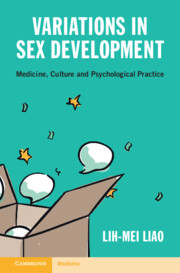Book contents
- Variations in Sex Development
- Reviews
- Variations in Sex Development
- Copyright page
- Dedication
- Contents
- Preface
- Abbreviations
- Section 1 Ordinary Lives
- Section 2 Medicalization and Resistance
- Chapter 2 Evolving Terms and Definitions
- Chapter 3 Medical and Psychological Controversies
- Chapter 4 Adult Outcome of Childhood Genital Surgery
- Chapter 5 Advocacy, Public Engagement and Healthcare Reform
- Chapter 6 The New Care Standard
- Section 3 Psychological Theories and Applications
- Section 4 Working Psychologically
- References
- Index
- Plate Section (PDF Only)
Chapter 3 - Medical and Psychological Controversies
from Section 2 - Medicalization and Resistance
Published online by Cambridge University Press: 18 November 2022
- Variations in Sex Development
- Reviews
- Variations in Sex Development
- Copyright page
- Dedication
- Contents
- Preface
- Abbreviations
- Section 1 Ordinary Lives
- Section 2 Medicalization and Resistance
- Chapter 2 Evolving Terms and Definitions
- Chapter 3 Medical and Psychological Controversies
- Chapter 4 Adult Outcome of Childhood Genital Surgery
- Chapter 5 Advocacy, Public Engagement and Healthcare Reform
- Chapter 6 The New Care Standard
- Section 3 Psychological Theories and Applications
- Section 4 Working Psychologically
- References
- Index
- Plate Section (PDF Only)
Summary
Not all sex variations are apparent at birth. Sometimes they are internal and therefore not visible, that is, children are born looking like a typical boy or girl. The child may be brought to medical attention much later, for example when puberty does not follow the expected path. Many of these care users were not told the truth about their biological variation because adults believed that the information would harm them. At the same time, the care users also noticed that they were fascinating to health professionals, who may examine them in droves. Some of them did not discover the truth about their diagnosis and the treatment until mid-life.
For children whose external genitalia look different, when surgical safety and techniques improved, it became routine to align the urogenital anatomy of newborns and young children to the assigned gender. The gender-genitalia alignment was believed to be important psychologically for child and family. Because surgeons found it easier to feminize than masculinize the genitalia, most babies with genital variations were assigned female. From the 1990s, some of these adults have spoken out, talking of too many operations, been too often examined by too many and not understanding what was happening.
Keywords
- Type
- Chapter
- Information
- Variations in Sex DevelopmentMedicine, Culture and Psychological Practice, pp. 32 - 45Publisher: Cambridge University PressPrint publication year: 2022



